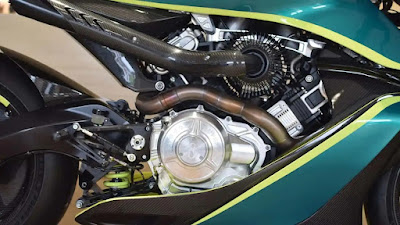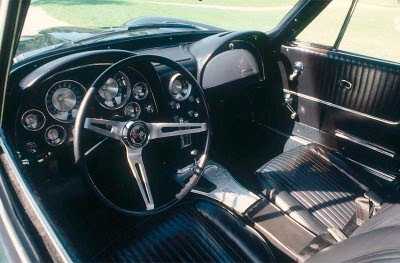New EV - In a much-anticipated move, Karma Automotive has unveiled its latest creation, the Karma Gyesera, at the prestigious Amelia Concours d'Elegance. After almost four years of eager anticipation since the initial revelation of plans to introduce a full-electric vehicle (EV) based on the Revero plug-in hybrid sedan, the Californian brand has taken a significant step into the future with this sleek four-door grand tourer.
 |
| Karma Automotive has unveiled its latest creation called the Karma Gyesera EV, at the prestigious Amelia Concours d'Elegance. (Picture from: AutomotiveNews) |
Described as a "bridge to the future" for Karma, the Gyesera showcases a thoroughly revamped design, housing a fully electric powertrain capable of an impressive 250-mile range. Aiming for a futuristic aesthetic, almost all of the exterior body panels have undergone a meticulous redesign, resulting in a 199.9-inch long model with a streamlined appearance. Notable updates include a grilleless nose, sculpted profile intakes, clear taillight lenses, and a modernized rear bumper.
 |
| The Karma Gyesera EV features a meticulously redesigned 199.9-inch-long frame, aspiring for a futuristic aesthetic through a streamlined overhaul of almost all exterior body panels. (Picture from: AutomotiveNews) |
Despite these exterior refinements, the Gyesera maintains the timeless proportions and greenhouse, reminiscent of its predecessors like the GS-6 and Revero plug-in hybrids. This design ethos harks back to the original Fisker Karma, which debuted in 2011, maintaining the iconic low-slung silhouette.
 |
| The Karma Gyesera's power lies in its 120 kWh battery pack, offering a commendable range of over 250 miles. (Picture from: AutomotiveNews) |
Internally, the Gyesera boasts an improved dashboard layout, echoing elements from the Fisker legacy. The center console has been revamped with a larger infotainment touchscreen, and the steering wheel has undergone a refreshing update. The absence of decorative inserts, coupled with the prominent Gyesera emblem on the dashboard, adds a touch of modern minimalism to the interior.
 |
| Internally, the Karma Gyesera boasts an improved dashboard layout, echoing elements from the Fisker legacy. (Picture from: AutomotiveNews) |
This unveiling is particularly significant as it marks the 10th anniversary since the acquisition of bankrupt Fisker Automotive by the Chinese company Wanxiang Group, subsequently rebranded as Karma Automotive.
President Marques McCammon emphasized the Gyesera's distinctiveness compared to its predecessor, the GSe-6. Although both models share the aluminum spaceframe chassis, the Gyesera introduces a "completely different" battery design and "materially different" performance, with 85% of the EV undergoing significant revisions.
 |
| The center console has been revamped with a larger infotainment touchscreen, and the steering wheel has undergone a refreshing update. (Picture from: AutomotiveNews) |
The Gyesera's power lies in its 120 kWh battery pack, offering a commendable range of over 250 miles. Its rear-mounted electric motor churns out an impressive 590 horsepower and 693 lb-ft of torque, translating to a rapid 0-60 mph sprint in under 4.2 seconds and a top speed exceeding 135 mph.
 |
| The Karma Gyesera EV introduces a "completely different" battery design and "materially different" performance, with 85% of the EV undergoing significant revisions. (Picture from: AutomotiveNews) |
Anticipated for a late 2024 or early 2025 market launch, the Gyesera comes with an estimated price tag ranging from $175,000 to $225,000. Karma Automotive aims for exclusivity, planning to produce 2,000 units over a four- or five-year period at its Moreno Valley facility in California.
 The Gyesera's debut sets the stage for Karma's future endeavors, with the Kaveya – a two-door electric sports car – expected to grace the production scene in late 2025. As Karma Automotive paves the way for the electric future, the Gyesera stands as a testament to innovation and design, propelling the brand into a new era of automotive excellence. *** [EKA | FROM VARIOUS SOURCES | KARMA AUTOMOTIVE | CARSCOOPS | CARANDDRIVER | AUTOMOTIVENEWS ]
The Gyesera's debut sets the stage for Karma's future endeavors, with the Kaveya – a two-door electric sports car – expected to grace the production scene in late 2025. As Karma Automotive paves the way for the electric future, the Gyesera stands as a testament to innovation and design, propelling the brand into a new era of automotive excellence. *** [EKA | FROM VARIOUS SOURCES | KARMA AUTOMOTIVE | CARSCOOPS | CARANDDRIVER | AUTOMOTIVENEWS ]Note: This blog can be accessed via your smart phone.




































